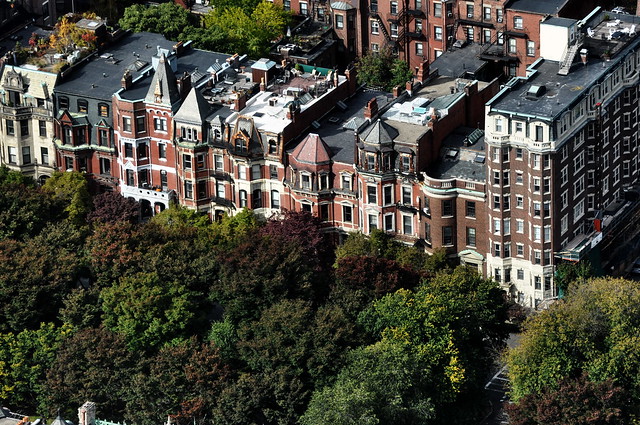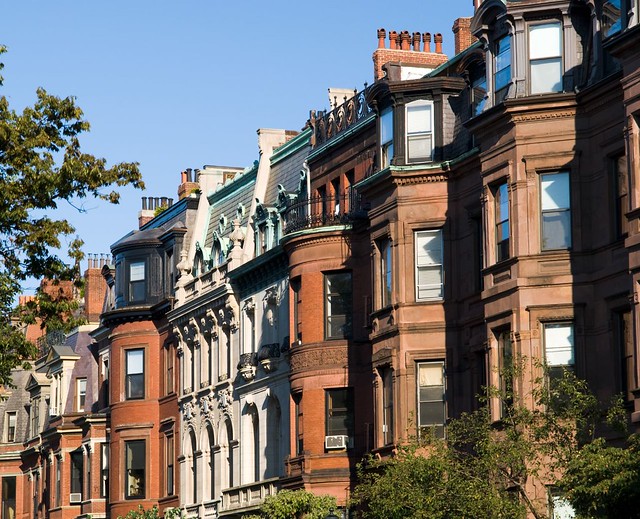Back Bay is a unique neighborhood, not just by Boston standards. Built on land reclaimed from a swamp, by the late 19th century it was the most popular area for the city's elite. Modeled on Parisian boulevards, the long, wide, tree-lined streets were a refreshing alternative to the narrow streets of Beacon Hill and the South End. To this day, Back Bay and Beacon Hill remain the two most affluent neighborhoods, with single family homes often selling for $10 million, sometimes more. While both boast historical architecture, however, the planned grid of Back Bay offers a much different experience and has been more prone to modern alterations due to its wider streets and proximity to commercial interests. Just south is a large business district with skyscrapers such as Prudential Tower.
Back Bay, in particular Newbury Street, is a popular shopping and entertainment area, with many upscale boutiques, cafes, and restaurants. Bordered by the Public Garden to the east and Charles River to the north, the neighborhood is well served by recreational green space, not to mention Commonwealth Avenue Mall, a wide grassy mall running the length of Commonwealth Avenue and forming a link with the Fens. This system of interconnected parks and gardens is called the Emerald Necklace and was designed by Frederick Law Olmsted, the preeminent landscape designer of the 19th century.
Sometimes Back Bay includes the business district just south of the residential streets, where one will find skyscrapers and other commercial buildings, but as usual I will not focus on this area. To me the border is Boylston Street. Oddly, a few streets south of the Turnpike are also officially included, but that's just silly, as there's nothing to distinguish the area from the bordering South End, with which the streets share their daily sphere. Unfortunately, I'm not doing a South End case study because Bing's Streetside doesn't extend there, and Google's Street View is very poor in dense, tree-lined urban environments. Still, it's a nice area so feel free to explore it on your own time. Anyway, on to Back Bay.
 |
| Most buildings are brick or brownstone so the few that aren't really stand out, especially the Burrage Mansion, built in 1899. The only example of a chateau style home in the city, it is now divided into 4 condos, one of which is selling for $4.7 million |
 |
| The grassy Mall is a constant presence on Commonwealth Avenue, running the length of Back Bay |
 |
| Unfortunately it's not the quiet residential area it once was, now a busy thoroughfare into downtown |
 |
| Silent sentinels, aged but still elegant |
 |
| The few apartment blocks are clustered on street corners |
 |
| The small gardens and stairs are good examples of soft borders between the homes and street |
 |
| Homes built for those wealthier than average are easily apparent by more flamboyant architecture |
 |
| Once the Hotel Vendome, 160 Commonwealth is now an expensive apartment building |
 |
| Once joined together as one large mansion, the home center-left recently sold for $8.75 million, center-right is available for $15 million and has 12,000 sq ft. It was built in 1882 |
 |
| Unlike an English terrace, various architects were involved to ensure a variety of styles |
 |
| Despite various styles, strict codes ensured architectural harmony |
 |
| The modest yet imposing terrace on the left was built in 1861 |
 |
| Once also residential, Newbury Street today is a popular shopping and entertainment area |
 |
| It sure beats a shopping mall, giving people a reason to stay and shop close to home |

 |
| A couple of mansions on the north side of Commonwealth Avenue, quite minimal by Victorian standards |
 |
| I really like the narrow home center-right, built in 1868. It has an assured, confident grace and a serene front entrace |
 |
| Despite being rowhomes, Back Bay homes manage to look detached or semi-detached due to the varying styles |
 |
| One of the larger corner mansions, 25-27 Commonwealth was built for a congressman in 1861. Today it is divided into 4 condos |
 |
| Because Back Bay was developed from east to west, the further one goes down Commonwealth, the newer the homes |
 |
| Unlike most modern architecture, old buildings lose none of their charm even when dirty |
 |
| The Ames-Webster Mansion, on Dartmouth St, is one of the largest homes in Back Bay, at 26,000 sq ft. On the market for $23 million, it was built in 1872 for industrialist/congressman Frederick Ames |
 |
| The mansion is so large, for the past few decades it's been used as an office building |
 |
| Marlborough Street is probably my favorite Back Bay road |
 |
| Relatively narrow and free of traffic, it's a quiet, purely residential area with many fine homes |
 |
| As in Baltimore, the sidewalk is red brick, which I think is a great touch that adds a great deal of texture to the streetscape |
 |
| I'm very glad that the original streetlights have been retained, adding a great deal of character to streets |
 |
| To me, traditional Victorian buildings with bowed windows always have something of a nautical disposition |
 |
| Beacon Street is the furthest north |
 |
| There's more apartment buildings on Beacon than elsewhere, less single-family dwellings |
I hope you've enjoyed this look at Back Bay. It must have been a huge undertaking, such a large project in the 19th century, first to reclaim the land from the swamp and then construct thousands of buildings. At eight blocks, from the Public Garden to Massachusetts Avenue, Back Bay is about 1.5 km long, almost a mile. All solidly built of masonry, either stone or brick, laboriously constructed over many decades. Likewise, the interiors almost all a work of craftsmanship. It's such a contrast when you think how such a project would be built today.
The neighborhood has managed to survive almost in its entirety, losing very little to "progress" and the wrecking ball. There's little doubt the character of Back Bay is starkly different today that it once was, however. Many of the single-family homes have been converted into multi-unit apartment buildings for young professionals, or into offices. The once calm and elegant procession of horse-drawn carriages has been replaced by fast moving cars and rumbling tourist buses. The movement of time has yielded one benefit, though, that of plentiful greenery, something which was lacking in those historical photos I posted earlier.
I do wonder just how popular the large homes of Back Bay and Beacon Hill are with present day Boston's elite. Doubtless as in other cities there's a significant group which has moved to the suburbs in search of large plots and cheaper homes. It should be noted as well that there's no public elementary school in Back Bay or Beacon Hill, because the limited amount of children in the area attend private schools such as Kingsley Montessori School, founded in 1938 and now based on Exeter Street in a grand Victorian building. Commonwealth School, an independent high school, is often rated as the best high school in Boston.
A concern I have with the neighborhood is its connection with Charles River, or rather lack thereof. In the 19th century it was very easy to access the recreational Esplanade, backing up directly to the neighborhood. Today, however, the busy six lane Storrow Drive is a barrier, and there are only a couple of pedestrian bridges over Storrow. It's a similar issue that the Marina in San Francisco faces, and unfortunately not much is likely to happen to rectify the problem as the Big Dig has drained the city's infrastructure budget for some years to come. It's a shame really, because the homes along the northern side of Beacon Street are diminished due to the back side facing the busy road rather than an esplanade and river. Moving Storrow Drive underground could immediately transform these homes from the least to the most desirable in Back Bay. One can dream.
For more images of Back Bay, there are plenty here.























































